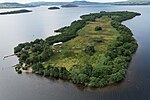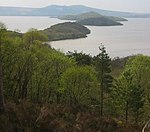Inchcailloch
Highland Boundary FaultIslands of Loch LomondLoch Lomond National Nature ReserveProtected areas of Stirling (council area)Uninhabited islands of Stirling (council area) ... and 1 more
Use British English from April 2020

Inchcailloch (Scottish Gaelic: Innis na Cailleach) is an islet on Loch Lomond in Scotland. It is 85 metres (279 ft) at its highest point. It is also known to some as Inchebroida. The name Inchcailloch means "Isle of the old woman" or "Isle of the Cowled (Hooded) Woman" in the Scottish Gaelic language. Saint Kentigerna went to Scotland from Ireland to preach and spread Christianity and the island is thought to be named after her.
Excerpt from the Wikipedia article Inchcailloch (License: CC BY-SA 3.0, Authors, Images).Inchcailloch
Central Path,
Geographical coordinates (GPS) Address Nearby Places Show on map
Geographical coordinates (GPS)
| Latitude | Longitude |
|---|---|
| N 56.081111111111 ° | E -4.5558333333333 ° |
Address
Central Path
Central Path
G63 0JS
Scotland, United Kingdom
Open on Google Maps









